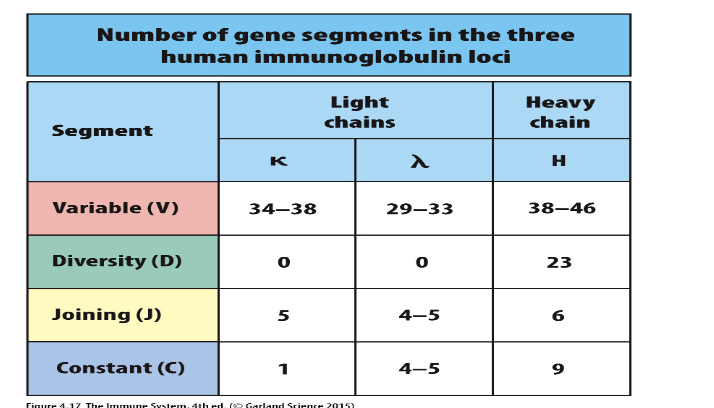Describe the genetic organization of the immunoglobulin heavy and light chain genes (V, D, J, and C regions)

V-Variable
J-Joining
D- Diversity
C-Constant
Randomness
heavy change
IgM is always in the first position.
Correctly identify the tissue in which VDJ recombination (of immunoglobulin genes) occurs (bone marrow).
...
Describe the general features of immunoglobulin gene rearrangement
7-23-9 recombination signal sequences (Two turn RSS)
J only have RSS on the upstream
V only have RSS on the downstream
D has RSS on both the up and downstream
General features of immunoglobulin gene rearrangement. How does it occur?
the rule
the RSS has to be different for the things to connect (one-turn and two can only connect not one-turn to one-turn)
Explain the function of the RSS sequences, RAG enzymes (VDJ recombinase), 1 turn-2 turn rule, etc.
...
Explain the meaning of allelic exclusion
...
explain why it is important for this to happen with respect to the immunoglobulin genes (ensures that each B cell only expresses one type of antibody and remains antigen-specific).
...
Explain the origins of P and N nucleotides
the
P and N nucleotides how they contribute to antibody diversity.
...
Understand the activity of the TdT enzyme in this process (it adds the N nucleotides).
...
Explain the process of somatic hypermutation
...
What does this process achieve? (hypermutation)
...
Correctly explain when this process occurs in the life of a B cell (during B cell clonal expansion in response to antigen binding)
...
correctly identify the tissues where it occurs (in secondary lymphoid tissues).
...
Explain how somatic hypermutation influences the affinity of an antibody for its antigen. (Explain what affinity maturation is).
...
Explain the process of class-switching.
...
Explain when this process occurs in a B cell’s developmental life
...
Explain the qualitative and quantitative differences between a primary antibody response and a secondary antibody response.
...